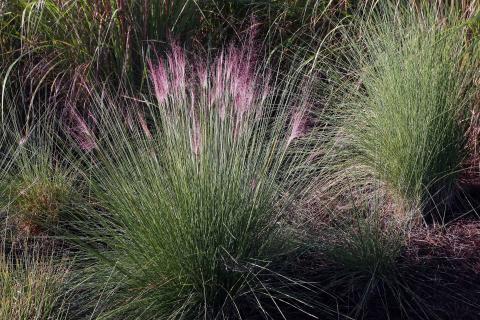
At least 232 species of grasses occur outside cultivation in Wisconsin. About 60% of these are native to the state, with the other 40% arriving since European settlement. One of the more recent arrivals is purple moorgrass. It probably was brought over as an ornamental grass, due to it’s clumping (“cespitose”) habit and attractive purplish seed stalks in late summer. Purple moorgrass (Molinia caerulea) is a perennial grass native to Europe, North Africa, the Caucasus region and Siberia. It was first documented in North America in Philadelphia, Pennsylvania in 1878. It is now established in the provinces of Nova Scotia, Quebec and Ontario, the northeastern United States, and in Wisconsin, Upper Michigan, and western Oregon. The populations in the Lake Superior region are of the taller subspecies arundinacea.
Across much of its native range, Purple moorgrass is a common and sometimes dominant grass where it is even considered “invasive” in some habitats. In recent decades it has increasingly dominated the much-loved “blanket bogs” of the UK and heathlands of western Europe, decreasing diversity and reducing carbon storage. (Interestingly, peatlands store the most carbon of any terrestrial ecosystem on the globe.) Molina’s increasing tendency to move into and dominate these nutrient-poor, boggy wetlands appears to be linked to increased nitrogen deposition from agricultural activities and the burning of fossil fuels. In Europe typical purple moorgrass habitats include intermittently waterlogged oak and pine forests, calcium rich fens, heathlands, seasonally wet grasslands, dry grasslands, and disturbed sites including roadside ditches and cut-over forests. Given the chance, it will likely colonize similar habits here. So far, two large populations of purple moorgrass are known from within the Ceded Territory.
One is in Ashland County, Wisconsin, where it dominates an old field and has spread to area roadsides and fields. It was apparently planted around a building there several decades ago. The other concentration is in Houghton County in the west central Upper Peninsula of Michigan, where it has transformed a large, peaty wetland (probably originally a “poor fen”) into a moorgrass monoculture.
As a “warm season” grass, Molina grows best during the sunny, warm months of summer. It is reasonable to assume that the warming climate will favor warm season grasses like purple moorgrass, to the detriment of cool-season grasses like the native common bluejoint, which grow best in spring and fall. Purple moorgrass will undoubtedly continue to spread in the Ceded Territory. The question now is what if anything should be done about it. It’s not really a problem for heavily disturbed areas like road corridors, which are mostly inhabited by common, weedy native and introduced species. But for purple moorgrass these corridors are highways to better habitats including natural peatlands and prairies, which support some unique elements of the region’s biological diversity. If action is to be taken to slow the spread of this plant, the best time is now. GLIFWC staff are reviewing potential management strategies. By Steve Garske, GLIFWC Invasive Species Coordinator
Moorgrass plants can grow to 6 feet tall, though 4-5 ft tall is more typical.